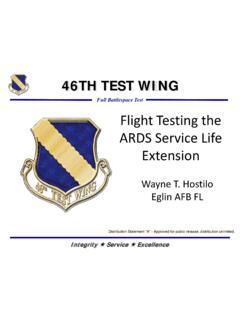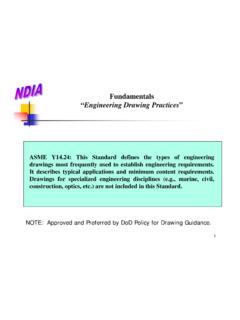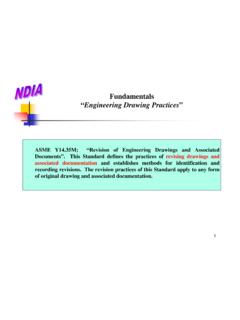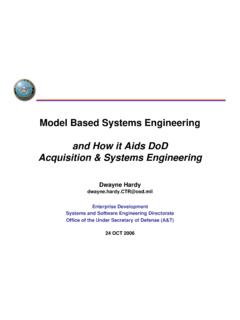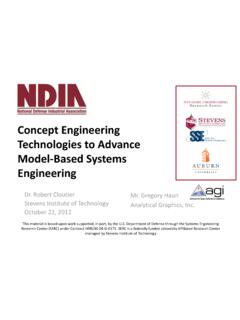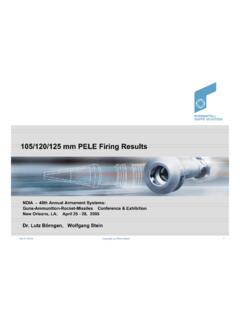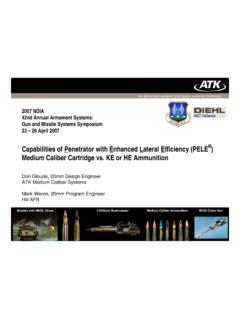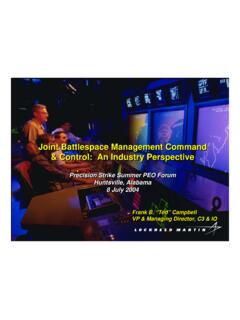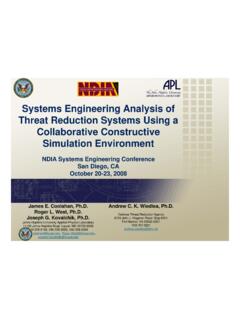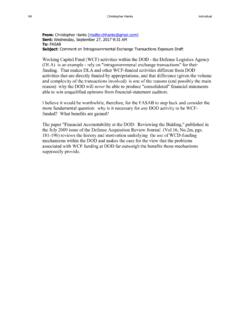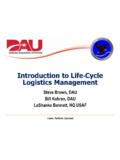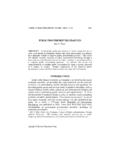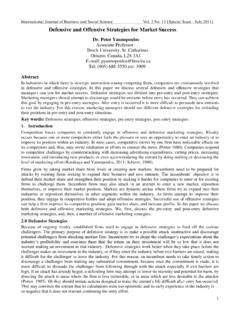Transcription of A Review Of Technical Performance and Technology Maturity ...
1 A Review Of Technical Performance and Technology Maturity approaches for improved developmental Test and Evaluation Assessment Alethea Rucker Headquarters Air Force, Directorate of Test and Evaluation (AF/TE) Shahram Sarkani, , Thomas A. Mazzuchi, The George Washington University NDIA Systems Engineering Conference Oct 22-25, 2012 This presentation is based on work leading to a dissertation submitted to The George Washington University in partial fulfillment of the Doctor of Philosophy Degree. Outline Overview Current efforts Literature Review Technology Maturity Technical Performance Risk Observations Future Work Conclusion Overview Purpose A Review of Technology Maturity and Technical Performance approaches to improve DT&E assessment Discuss the mutual beneficial relationship between the SE and T&E communities Motivation A need for a tangible means to quantitatively assess Technical readiness in order to transition from DT to IOT&E Current efforts The DASD(DT&E) office is working to institutionalize the process and use of metrics to improve MDAP success in entering and exiting IOT&E.
2 A framework, along with an initial set of Performance criteria and associated metrics, was developed. Effort resulted in development of 14 Performance criteria Department of defense . (2011). DoD developmental Test and Evaluation and Systems Engineering FY2011 Annual Report. Performance Criteria Performance parameters (KPPs) are functionally traceable to Warfighter capabilities.* are evaluated for mission capabilities. evaluation framework for KPPs and critical Technical parameters (CTPs). evaluation framework for KPPs and CTPs.* Technical progress and system Maturity . safety of the system.* adequacy and currency. resource management. phase schedule Performance . to T&E policy and process.* program effectiveness and efficiency.* accuracy. workforce certification status. identified T&E KLPs. (*) Requires further study to determine value and applicability Department of defense .
3 (2011). DoD developmental Test and Evaluation and Systems Engineering FY2011 Annual Report. Measurable Performance Criteria As part of the framework, the DASD(DT&E) developed a method for assessment. For each Performance criterion, the Action Officer (AO) both assesses Performance against the particular criterion and provides a confidence level in making the assessment. For the Performance assessment, the DASD(DT&E) uses the stoplight colors of green, yellow, and red. The meaning of each stoplight assessment color was developed uniquely for each criterion to reflect the proper status. A Not Rated assessment is also available, as appropriate. Department of defense . (2011). DoD developmental Test and Evaluation and Systems Engineering FY2011 Annual Report. Current Confidence Assessment High confidence is assessed when the presence and Maturity of program T&E artifacts and documentation is consistent with expectations at the program s point in its life cycle.
4 Medium confidence is assessed when the presence of program T&E artifacts and documentation is consistent with expectations at the program s point in its life cycle, but detail and Maturity of documentation is lacking. Low confidence is assessed when there are omissions, gaps, inconsistencies, lack of expected detail, and/or conflicting data and information observed in program T&E artifacts and documentation. Subjective and oversimplifies Performance criteria! Department of defense . (2011). DoD developmental Test and Evaluation and Systems Engineering FY2011 Annual Report. Evaluation Framework Establish evaluation framework for KPPs and critical Technical parameters (CTPs). Execute evaluation framework for KPPs and CTPs. DT&E Assessment Assess Technical progress and Maturity against critical Technical parameters (CTPs), key system attributes (KSAs), KPPs, and critical operational issues (COIs) as documented in the TEMP and test plans (DAU, 2012) CTPs can be used to assess completion of a major phase of developmental testing such as ground or flight testing.
5 And determine readiness to enter the next phase of testing, whether developmental or operational (DAU, 2012) Critical Technical Parameters Definition: CTPs measure critical system characteristics that, when achieved, enable the attainment of desired operational Performance capabilities (DAU, 2012) Every Technical parameter is NOT a CTP CTPs focuses on critical design features or risk areas ( , Technical Maturity , RAM issues, physical characteristics or measures) that if not achieved or resolved during development will preclude delivery of required operational capabilities (DAU, 2012) How are CTPs derived? Mosser-Kerner, D. (2009). Test & Evaluation Strategy for Technology Development Phase . Presented at NDIA Systems Engineering Conference. CTPs can be established from CTEs, TMPs, SE, etc. Technical Progress and Maturity Demonstrated Technical progress and system Maturity . Problem Statement Objective and robust methods that can assess Technology Maturity accurately and provide insight into risks that lead to cost overruns, schedule delays, and Performance degradation are imperative for making well-informed procurement decisions.
6 (Azizian et al, 2009) The Weapon System acquisition Reform Act of 2009 recognized that unrealistic Performance expectations and immature technologies are among the root causes of trouble in defense programs (Gilmore, 2011) Reduce risk of immature Technology in systems development (Stuckey, 2007) Programs that started development with immature technologies experienced an average acquisition unit cost increase of nearly 21 percent (GAO-05-301, 2005) Technical versus Technology Maturity Assessing the Maturity of a particular Technology involves determining its readiness for operations across a spectrum of environments with a final objective of transitioning it to the user. Application to an acquisition program also includes determining the fitness of a particular Technology to meet the customer's requirements and desired outcome for operations (MITRE, 2012) Stuckey, R. (2007). OSD DT&E Perspective: Technology Development and Maturation , Presented at AFRL Technology Maturity Conference.
7 Technology Maturity Immature Technology is a primary source of cost and schedule risk (Stuckey, 2007) Recommendation was to add Technology Maturity focus into the SE and DT&E processes (Stuckey, 2007) TRL verification Not recommended due to numerous TRL limitations (Azizian et al, 2009) Subjective Focused on hardware Lacks accuracy and precision Not focused on system-to-system integration Does not communicate difficulty of maturing Technology to higher TRL levels Increasing complexity of defense systems Technical Performance Risk Little is available on how to integrate Technical Performance measures into a meaningful measure of system s overall Performance risk (Garvey and Cho, 2003) 2003: Developed a Performance Risk Index Measure 2004: Extended previous work to measure and monitor a System-of-Systems Performance Risk TRLs does not measure how well the Technology is performing against a set of Performance criteria (Mahafza, 2005) 2006: Developed Technology Performance Risk Measure Technology Performance Risk Measure Mahafza, S.
8 (2004). Technology Performance Risk Measure . Presented at Multi-Dimensional Assessment of Technology Maturity Workshop. Measures Performance risk of Technology in order to determine transition readiness Computed using Performance requirements, the DD, and unmet Performance SoS Technical Performance Risk Index Garvey, and Cho, (2004). An Index to Measure and Monitor a System-of-Systems Performance Risk , The MITRE Corporation. Provides integrated measures of Technical Performance Measures Technical Performance as a function of the physical parameters of the TPMs Measures the degree of risk and monitors change over time MBSE Framework for T&E Bjorkman, , Sarkarni, S., and Mazzuchi, (2012). Using Model-Based Systems Engineering as a Framework for Improving Test and Evaluation Activities , Unpublished. Uses MBSE framework and Monte Carlo Simulation to define uncertainty reduction goals for test planners to use in developing test strategies and detailed test designs for evaluating Technical Performance parameters Dr Bjorkman proposed a methodology to determine test value by estimating the amount of uncertainty reduction a particular test is expected to provide using Shannon s Information Entropy as a basis for the estimate Observations Focus has been on cost and schedule; Technical Performance often an afterthought Recent emphasis on test planning and test design Need to redirect and increase focus on test analysis and reporting Immature technologies still an issue T&E interests need to be injected up front Critical Technical parameter risks should be primary intent of research What do we go from here?
9 Future Work Assess system s progress and Maturity against critical Technical parameters as documented in the TEMP Integrate and quantify risk and uncertainty into CTPs Analyze and aggregate data using information theoretic approaches Shannon s information entropy; entropy as a risk measure Use Model-based Systems Engineering (MBSE) to continuously track and update various readiness levels Extend uncertainty reduction and MBSE research by Dr. Bjorkman into CTP reporting Roll values into a holistic decision making model Report decision making model at upcoming T&E conference and STAT Panel Meeting Summary Need for critical Technical Performance risk index Inject Technology Maturity and uncertainty SE and T&E communities need to collaborate on development and tracking of Technical Performance , specifically CTPs, per DoDI T&E community needs to be involved as early as possible (pre-MS B) Keep moving forward with Contact Information Alethea Rucker (703) 697-0296 ShahramSarkani, , Thomas A.
10 Mazzuchi, References Azizian, N., Sarkarni, S., and Mazzuchi, T. (2009) A Comprehensive Review and Analysis of Maturity Assessment approaches for improved Decision Support to Achieve Efficient defense acquisition , Proceedings of the World Congress on Engineering and Computer Science, Vol II. Bjorkman, , Sarkarni, S., and Mazzuchi, (2012). Using Model-Based Systems Engineering as a Framework for Improving Test and Evaluation Activities , Unpublished. defense acquisition University. (2012) defense acquisition Guide, Chapter 9. Department of defense . (2011). DoD developmental Test and Evaluation and Systems Engineering FY2011 Annual Report. Department of defense Instruction, DoDI (2011). Deputy Assistant Secretary of defense for developmental Test and Evaluation (DASD(DT&E)). Department of defense . (2011). DOT&E FY 2011 Annual Report . Garvey, and Cho, (2004). An Index to Measure and Monitor a System-of-Systems Performance Risk , The MITRE Corporation.
